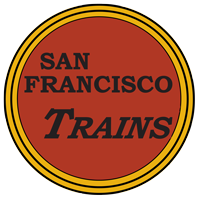Construction and Shipment
Which comes first – the engine or the specifications? The first glimpse of the 100-year history of State Belt #4 is “Specifications for a Six Wheel Switching Locomotive” (PDF, 5MB), an 11-page document written by California’s State Board of Harbor Commissioners in San Francisco. Written on December 10, 1910, it picked up Assistant State Engineer Ralph Barker’s signature of approval on the 29th and by late January of 1911 had made its way (evidently through local dealer Harron, Rickard & McCone) to Vulcan Iron Works of Wilkes-Barre, PA… where it caused some confusion.
Reading over “Specifications for,” it becomes apparent that it was less of a carefully compiled technical document and more of a chronologically transcribed committee meeting, if the inconsistent formatting and misplaced specifications are anything to go by. The main rods are specified to be “same as on Engine 1,” an engine which only its particular builder (Baldwin) would have any prior knowledge of, in a sentence which is disjointedly inserted between unrelated items rather than under “rods.” This and the non-sentence “Slide valves Piston valves” (possibly a missing “or” between them as implied elsewhere in the specifications) inserted at the end of the “valve motion” category were confusing enough, but there were at least two other items which the small-time Pennsylvanian builder was unfamiliar with: the “D&RG never clog sander” and “S.P. standard” oil burning fittings. Though Vulcan had built oil burning steam locomotives before*, Southern Pacific was not among their customers and evidently none had asked for that railroad’s standard oil burning fittings before, as the Board was now doing.
*Contrary to our prior belief, No. 4 was not Vulcan’s first oil burner. See our page about oil burning steam locomotives for discussion of this.
Vulcan sent H.R. McCone to meet with the Board and clear things up. Master Mechanic H.C. Martin and Superintendent Burnham, evidently disagreeing with the ambivalence of the specifications, cleared up the valve issue by stating that “what they want and must have is the piston valve cylinder.” The rods being the “same as on Engine 1” was clarified to mean “having solid ends, no straps, except on the back end of the main rod, which is to have straps.” As for unfamiliar equipment, Mr. Martin responded with borrowed SP blueprints and a shipment of related parts purchased “at his own personal expense.”
H. R. McCone relayed the above back to Vulcan on February 16, but one area which required more time to determine was the firebox interior… which the astute may notice was supposed to have all equipment “furnished and applied by [the] Railway Company” (i.e. not Vulcan) in the original specifications. We only have the text of H.R. McCone’s replies to Vulcan’s initial January 31 inquiry, so it’s unclear if Vulcan genuinely skipped over that part or if something else prompted H.R. McCone to delve into this. The decision eventually reached was that the interior was to be set up on the factory floor in Wilkes-Barre using a patented arrangement, with all royalties and expenses to be paid by the Board. H.R. McCone delivered the news as well as a forwarded letter (PDF, 407kB) from patent holder Aetna Combustion Company on February 27.
With all the specifications clarified and a shipment of pre-purchased parts on the way, Vulcan began construction of their 1,759th locomotive. A delivery date of May 30, 1911 was initially projected, but there were evidently complications and the delivery was delayed to July 3. The locomotive’s cross-country journey was carried out on its own wheels and attended by Vulcan representative C. W. Bowen.

